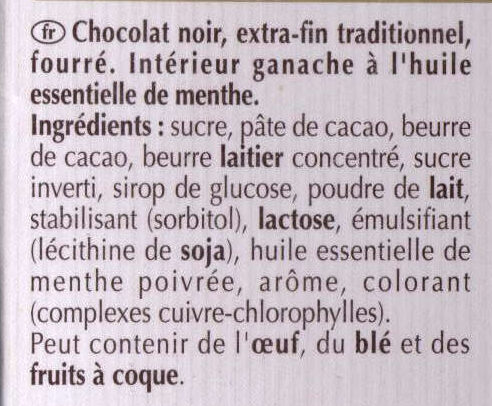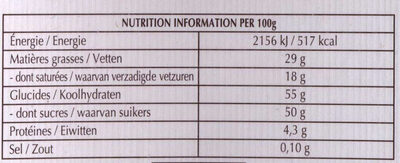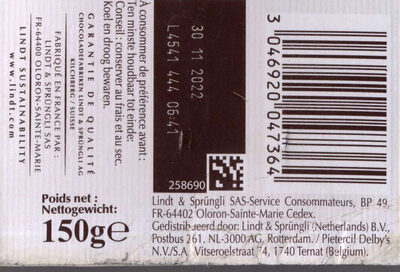Help us make food transparency the norm!
As a non-profit organization, we depend on your donations to continue informing consumers around the world about what they eat.
The food revolution starts with you!
Création - Menthe Frappée - Lindt - 150 g
Création - Menthe Frappée - Lindt - 150 g
Barra-kodea: 3046920047364 (EAN / EAN-13)
Izen arrunta: Chocolat noir, extra fin traditionnel, fourré. Intérieur ganache à l'huile essentielle de menthe
Kopurua: 150 g
Ontziratzea: en:Metal, en:Cardboard, en:Recyclable Metals, 41 ALU, en:Sleeve
Markak: Lindt, Lindt & Sprüngli
Kategoriak: en:Snacks, en:Sweet snacks, en:Cocoa and its products, en:Chocolates, en:Dark chocolates, en:Filled chocolates, en:Dark chocolate filled with mint confectionery, en:Extra fine dark chocolates, en:Filled dark chocolates
Etiketak, ziurtagiriak, sariak:
Triman
Origin of ingredients: en:Unspecified
Manufacturing or processing places: France
Link to the product page on the official site of the producer: https://www.lindt.fr/shop/tablette-lindt...
Dendak: Carrefour, Carrefour Market, Carrefour Contact, Carrefour City, E.leclerc, Auchan, Cora, Franprix, Monoprix, Leclerc
Matching with your preferences
Health
Osagaiak
-
16 ingredients
: Sucre, pâte de cacao, beurre de cacao, beurre laitier concentré, sucre inverti, sirop de glucose, poudre de lait, stabilisant (sorbitol), lactose, émulsifiant (lécithine de soja), huile essentielle de menthe poivrée, arôme, colorant (complexes cuivre-chlorophylles).Alergenoak: en:Milk, en:SoybeansAztarnak: en:Eggs, en:Gluten, en:Nuts
Food processing
-
Ultra processed foods
Elements that indicate the product is in the 4 - Ultra prozesatutako elikagaiak eta edariak group:
- Gehigarria: E141
- Gehigarria: E322
- Gehigarria: E420
- Osagaia: Colour
- Osagaia: Emulsifier
- Osagaia: Flavouring
- Osagaia: Glukosa
- Osagaia: Almibar
- Osagaia: Invert sugar
- Osagaia: Laktosa
Food products are classified into 4 groups according to their degree of processing:
- Prozesatu gabeko edo ahalik eta gutxien prozesatutako elikagaiak
- Sukaldaritzako osagaiak prozesatu
- Prozesatutako jakiak
- Ultra processed foods
The determination of the group is based on the category of the product and on the ingredients it contains.
Gehigarriak
-
E322
Lecithin: Lecithin -UK: , US: , from the Greek lekithos, "egg yolk"- is a generic term to designate any group of yellow-brownish fatty substances occurring in animal and plant tissues, which are amphiphilic – they attract both water and fatty substances -and so are both hydrophilic and lipophilic-, and are used for smoothing food textures, dissolving powders -emulsifying-, homogenizing liquid mixtures, and repelling sticking materials.Lecithins are mixtures of glycerophospholipids including phosphatidylcholine, phosphatidylethanolamine, phosphatidylinositol, phosphatidylserine, and phosphatidic acid.Lecithin was first isolated in 1845 by the French chemist and pharmacist Theodore Gobley. In 1850, he named the phosphatidylcholine lécithine. Gobley originally isolated lecithin from egg yolk—λέκιθος lekithos is "egg yolk" in Ancient Greek—and established the complete chemical formula of phosphatidylcholine in 1874; in between, he had demonstrated the presence of lecithin in a variety of biological matters, including venous blood, in human lungs, bile, human brain tissue, fish eggs, fish roe, and chicken and sheep brain. Lecithin can easily be extracted chemically using solvents such as hexane, ethanol, acetone, petroleum ether, benzene, etc., or extraction can be done mechanically. It is usually available from sources such as soybeans, eggs, milk, marine sources, rapeseed, cottonseed, and sunflower. It has low solubility in water, but is an excellent emulsifier. In aqueous solution, its phospholipids can form either liposomes, bilayer sheets, micelles, or lamellar structures, depending on hydration and temperature. This results in a type of surfactant that usually is classified as amphipathic. Lecithin is sold as a food additive and dietary supplement. In cooking, it is sometimes used as an emulsifier and to prevent sticking, for example in nonstick cooking spray.Source: Wikipedia (Ingeles)
-
E322i - Lezitina
Lecithin: Lecithin -UK: , US: , from the Greek lekithos, "egg yolk"- is a generic term to designate any group of yellow-brownish fatty substances occurring in animal and plant tissues, which are amphiphilic – they attract both water and fatty substances -and so are both hydrophilic and lipophilic-, and are used for smoothing food textures, dissolving powders -emulsifying-, homogenizing liquid mixtures, and repelling sticking materials.Lecithins are mixtures of glycerophospholipids including phosphatidylcholine, phosphatidylethanolamine, phosphatidylinositol, phosphatidylserine, and phosphatidic acid.Lecithin was first isolated in 1845 by the French chemist and pharmacist Theodore Gobley. In 1850, he named the phosphatidylcholine lécithine. Gobley originally isolated lecithin from egg yolk—λέκιθος lekithos is "egg yolk" in Ancient Greek—and established the complete chemical formula of phosphatidylcholine in 1874; in between, he had demonstrated the presence of lecithin in a variety of biological matters, including venous blood, in human lungs, bile, human brain tissue, fish eggs, fish roe, and chicken and sheep brain. Lecithin can easily be extracted chemically using solvents such as hexane, ethanol, acetone, petroleum ether, benzene, etc., or extraction can be done mechanically. It is usually available from sources such as soybeans, eggs, milk, marine sources, rapeseed, cottonseed, and sunflower. It has low solubility in water, but is an excellent emulsifier. In aqueous solution, its phospholipids can form either liposomes, bilayer sheets, micelles, or lamellar structures, depending on hydration and temperature. This results in a type of surfactant that usually is classified as amphipathic. Lecithin is sold as a food additive and dietary supplement. In cooking, it is sometimes used as an emulsifier and to prevent sticking, for example in nonstick cooking spray.Source: Wikipedia (Ingeles)
-
E420
Sorbitol: Sorbitol --, less commonly known as glucitol --, is a sugar alcohol with a sweet taste which the human body metabolizes slowly. It can be obtained by reduction of glucose, which changes the aldehyde group to a hydroxyl group. Most sorbitol is made from corn syrup, but it is also found in nature, for example in apples, pears, peaches, and prunes. It is converted to fructose by sorbitol-6-phosphate 2-dehydrogenase. Sorbitol is an isomer of mannitol, another sugar alcohol; the two differ only in the orientation of the hydroxyl group on carbon 2. While similar, the two sugar alcohols have very different sources in nature, melting points, and uses.Source: Wikipedia (Ingeles)
Ingredients analysis
-
en:May contain palm oil
Ingredients that may contain palm oil: en:Butterfat
-
en:Non-vegan
Non-vegan ingredients: en:Butterfat, en:Milk powder, LaktosaSome ingredients could not be recognized.
We need your help!
You can help us recognize more ingredients and better analyze the list of ingredients for this product and others:
- Edit this product page to correct spelling mistakes in the ingredients list, and/or to remove ingredients in other languages and sentences that are not related to the ingredients.
- Add new entries, synonyms or translations to our multilingual lists of ingredients, ingredient processing methods, and labels.
If you would like to help, join the #ingredients channel on our Slack discussion space and/or learn about ingredients analysis on our wiki. Thank you!
-
en:Vegetarian status unknown
Unrecognized ingredients: en:Invert sugar, fr:huile-essentielle-de-menthe-poivreeSome ingredients could not be recognized.
We need your help!
You can help us recognize more ingredients and better analyze the list of ingredients for this product and others:
- Edit this product page to correct spelling mistakes in the ingredients list, and/or to remove ingredients in other languages and sentences that are not related to the ingredients.
- Add new entries, synonyms or translations to our multilingual lists of ingredients, ingredient processing methods, and labels.
If you would like to help, join the #ingredients channel on our Slack discussion space and/or learn about ingredients analysis on our wiki. Thank you!
-
Details of the analysis of the ingredients
We need your help!
Some ingredients could not be recognized.
We need your help!
You can help us recognize more ingredients and better analyze the list of ingredients for this product and others:
- Edit this product page to correct spelling mistakes in the ingredients list, and/or to remove ingredients in other languages and sentences that are not related to the ingredients.
- Add new entries, synonyms or translations to our multilingual lists of ingredients, ingredient processing methods, and labels.
If you would like to help, join the #ingredients channel on our Slack discussion space and/or learn about ingredients analysis on our wiki. Thank you!
: Sucre, pâte de cacao, beurre de cacao, beurre laitier concentré, sucre inverti, sirop de glucose, poudre de lait, stabilisant (sorbitol), lactose, émulsifiant (lécithine de soja), huile essentielle de menthe poivrée, arôme, colorant (complexes cuivre-chlorophylles)- Sucre -> en:sugar - vegan: yes - vegetarian: yes - ciqual_proxy_food_code: 31016 - percent_min: 7.69230769230769 - percent_max: 100
- pâte de cacao -> en:cocoa-paste - vegan: yes - vegetarian: yes - ciqual_proxy_food_code: 16030 - percent_min: 0 - percent_max: 50
- beurre de cacao -> en:cocoa-butter - vegan: yes - vegetarian: yes - ciqual_food_code: 16030 - percent_min: 0 - percent_max: 33.3333333333333
- beurre laitier concentré -> en:butterfat - vegan: no - vegetarian: yes - from_palm_oil: maybe - ciqual_food_code: 16401 - percent_min: 0 - percent_max: 25
- sucre inverti -> en:invert-sugar - percent_min: 0 - percent_max: 20
- sirop de glucose -> en:glucose-syrup - vegan: yes - vegetarian: yes - ciqual_proxy_food_code: 31016 - percent_min: 0 - percent_max: 16.6666666666667
- poudre de lait -> en:milk-powder - vegan: no - vegetarian: yes - ciqual_proxy_food_code: 19044 - percent_min: 0 - percent_max: 14.2857142857143
- stabilisant -> en:stabiliser - percent_min: 0 - percent_max: 12.5
- sorbitol -> en:e420 - vegan: yes - vegetarian: yes - percent_min: 0 - percent_max: 12.5
- lactose -> en:lactose - vegan: no - vegetarian: yes - percent_min: 0 - percent_max: 11.1111111111111
- émulsifiant -> en:emulsifier - percent_min: 0 - percent_max: 10
- lécithine de soja -> en:soya-lecithin - vegan: yes - vegetarian: yes - ciqual_food_code: 42200 - percent_min: 0 - percent_max: 10
- huile essentielle de menthe poivrée -> fr:huile-essentielle-de-menthe-poivree - percent_min: 0 - percent_max: 9.09090909090909
- arôme -> en:flavouring - vegan: maybe - vegetarian: maybe - percent_min: 0 - percent_max: 5
- colorant -> en:colour - percent_min: 0 - percent_max: 5
- complexes cuivre-chlorophylles -> en:e140i - vegan: yes - vegetarian: yes - percent_min: 0 - percent_max: 5
Elikadura
-
Bad nutritional quality
⚠ ️Abisua: zuntz kopurua ez dago zehaztuta, ezin izan dute kontuan izan kalifikaziorako izan dezaketen ekarpen positiboa.⚠ ️Warning: the amount of fruits, vegetables and nuts is not specified on the label, it was estimated from the list of ingredients: 0This product is not considered a beverage for the calculation of the Nutri-Score.
Positive points: 0
- Proteinak: 2 / 5 (balioa: 4.3, rounded value: 4.3)
- Fiber: 0 / 5 (balioa: 0, rounded value: 0)
- Fruits, vegetables, nuts, and colza/walnut/olive oils: 0 / 5 (balioa: 0, rounded value: 0)
Negative points: 26
- Energia: 6 / 10 (balioa: 2156, rounded value: 2156)
- Azukreak: 10 / 10 (balioa: 50, rounded value: 50)
- Gantz saturatua: 10 / 10 (balioa: 18, rounded value: 18)
- Sodioa: 0 / 10 (balioa: 40, rounded value: 40)
The points for proteins are not counted because the negative points are greater or equal to 11.
Nutritional score: (26 - 0)
Nutri-Score:
-
Nutrient levels
-
Koipe in high quantity (29%)
What you need to know- A high consumption of fat, especially saturated fats, can raise cholesterol, which increases the risk of heart diseases.
Recommendation: Limit the consumption of fat and saturated fat- Choose products with lower fat and saturated fat content.
-
Gantz-azido ase in high quantity (18%)
What you need to know- A high consumption of fat, especially saturated fats, can raise cholesterol, which increases the risk of heart diseases.
Recommendation: Limit the consumption of fat and saturated fat- Choose products with lower fat and saturated fat content.
-
Azukre in high quantity (50%)
What you need to know- A high consumption of sugar can cause weight gain and tooth decay. It also augments the risk of type 2 diabetes and cardio-vascular diseases.
Recommendation: Limit the consumption of sugar and sugary drinks- Sugary drinks (such as sodas, fruit beverages, and fruit juices and nectars) should be limited as much as possible (no more than 1 glass a day).
- Choose products with lower sugar content and reduce the consumption of products with added sugars.
-
Gatz arrunt in low quantity (0.1%)
What you need to know- A high consumption of salt (or sodium) can cause raised blood pressure, which can increase the risk of heart disease and stroke.
- Many people who have high blood pressure do not know it, as there are often no symptoms.
- Most people consume too much salt (on average 9 to 12 grams per day), around twice the recommended maximum level of intake.
Recommendation: Limit the consumption of salt and salted food- Reduce the quantity of salt used when cooking, and don't salt again at the table.
- Limit the consumption of salty snacks and choose products with lower salt content.
-
-
Nutrition facts
Nutrition facts As sold
for 100 g / 100 mlCompared to: en:Filled dark chocolates Energia 2.156 kj
(517 kcal)+% 1 Koipe 29 g -% 5 Gantz-azido ase 18 g +% 3 Carbohydrates 55 g +% 7 Azukre 50 g +% 11 Fiber ? Proteina 4,3 g -% 19 Gatz arrunt 0,1 g +% 68 Fruits‚ vegetables‚ nuts and rapeseed‚ walnut and olive oils (estimate from ingredients list analysis) 0 %
Ingurumena
-
Eco-Score D - High environmental impact
The Eco-Score is an experimental score that summarizes the environmental impacts of food products.→ The Eco-Score was initially developped for France and it is being extended to other European countries. The Eco-Score formula is subject to change as it is regularly improved to make it more precise and better suited to each country.Life cycle analysis
-
Average impact of products of the same category: D (Score: 35/100)
Kategoria: Dark chocolate, filled with mint confectionery
Kategoria: Dark chocolate, filled with mint confectionery
- PEF environmental score: 0.89 (the lower the score, the lower the impact)
- including impact on climate change: 17.11 kg CO2 eq/kg of product
Stage Impact Agriculture
14.3 %Processing
81.0 %Ontziratzea
1.2 %Transportation
3.0 %Distribution
0.5 %Consumption
0.0 %
Bonuses and maluses
-
Origins of ingredients with a high impact
Malus: -5
Environmental policy: -5
Transportation: 0
Origin of the product and/or its ingredients % of ingredients Impact Unspecified 100 %Altua
-
Packaging with a low impact
Malus: -1
Shape Material Recycling Impact 1 Sleeve 23 PBD Recycle Baxua 1 Sheet Aluminio arina Discard Medium
Eco-Score for this product
-
Impact for this product: D (Score: 29/100)
Produktua: Création - Menthe Frappée - Lindt - 150 g
Life cycle analysis score: 35
Sum of bonuses and maluses: -6
Final score: 29/100
-
Carbon footprint
-
Equal to driving 8.9 km in a petrol car
1711 g CO² per 100g of product
The carbon emission figure comes from ADEME's Agribalyse database, for the category: Dark chocolate, filled with mint confectionery (Source: ADEME Agribalyse Database)
Stage Impact Agriculture
8.6 %Processing
89.2 %Ontziratzea
0.6 %Transportation
1.6 %Distribution
0.1 %Consumption
0.0 %
Ontziratzea
-
Packaging with a low impact
-
Packaging parts
1 x Sleeve 150 g (23 PBD)
1 x Sheet (41 ALU)
-
Bilgarriaren materialak
Material % Bilgarriaren pisua Bilgarriaren pisua produktuaren 100g-ko Paper or cardboard Metal Guztira
-
Transportation
-
Origins of ingredients
Origins of ingredients with a high impact
Origin of the product and/or its ingredients % of ingredients Impact Unspecified 100 %Altua
Report a problem
-
Incomplete or incorrect information?
Category, labels, ingredients, allergens, nutritional information, photos etc.
If the information does not match the information on the packaging, please complete or correct it. Open Food Facts is a collaborative database, and every contribution is useful for all.
Datuen iturria
Product added on by phoenix
Last edit of product page on by bugmenot.
Produktuaren orria -gatik editatua bridum, date-limite-app, didierg, dorado-jerome, driveoff, kiliweb, moon-rabbit, off.60dc1beb-05b0-4e5e-b817-8ab37b3e7c9b, openfoodfacts-contributors, packbot, pierrelm, quechoisir, roboto-app, thaialagata, yuka.V3IwR0Zic3ppdUl3dzhJOHd5Nk8rdDlJK0s3eVdXQ2NKOVlTSWc9PQ, yuka.sY2b0xO6T85zoF3NwEKvlhYeeIPzmgnoajnin0zTm-utPsO5OeNj77Hnbqo, yuka.sY2b0xO6T85zoF3NwEKvlnZKTsHDnW3JKjvUlEiMwsicL5HsPelT6If2Pqs.












